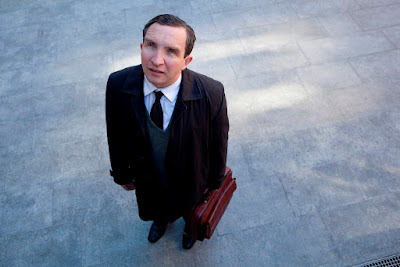Uberto Pasolini’s contemplative drama on loneliness and
alienation, Still Life (2013) opens with the shot of a cemetery, followed by a
funeral ceremony attended by a single mourner that includes a refined eulogy,
read by the priest. Over the next few somberly framed vignettes, we see the
same parochial and calm man, dressed in the same greyed, drab suit, solitarily
attending different funerals. But Still Life (2013) isn’t a movie about funeral and death.
It’s a gentle drama about finding life. “Each man’s life touches so many other
lives. When he isn't around he leaves an awful hole, doesn't he?” says
the angel in Frank Capra’s classic melodrama It’s A Wonderful Life (1946). Writer/director
Pasolini takes a largely meditative approach to examine the empty hollow feeling following a loss, and in turn cherishes life’s value, irrespective of the human foibles
and mistakes.
 |
Uberto Pasolini, an investment banker and economist,
embarked into cinema by taking up the role of producer in the highly acclaimed
British drama The Full Monty (1997). He made his directorial debut with sports
comedy Machan (2008), which was about Singhalese handball players, invited to a
tournament in Bavaria, Germany. Although less-seen, the film perceived the
themes of illegal immigration and poverty with sensitivity and lucidity, rarely
found in Hollywood movies (made on the same subject).
Pasolini is the grand
nephew of legendary Italian film-maker Luchino Visconti, whose masterpieces The
Earth Trembles (1948) and Rocco and his Brothers (1960) centered on
immigration. For his second film, Pasolini has chosen the theme of isolation,
something that broadly resonates with the western society. Pasolini in an
interview (to Cineuropa) states the idea for a film came from the visual of a
solitary burial and a London newspaper interview of a Westminster funeral
officer. Over the next few months, Pasolini met other funeral officers and
gradually molded the character of John May.
Eddie Marsan is the perfect choice for the lead role. He is
known for playing violent, demented individuals, the ones that are defined as character
roles. Although he has worked with top-notch directors like Martin Scorsese,
Terrence Malick, Steven Spielberg, Michael Mann, Mike Leigh, Still Life marks
his rare protagonist role. Blessed with a deep, empathetic set of eyes and a
dignified smile, Eddie Marsan easily erases our memory of seeing him as the
short, crazy guy and makes us embraces this meticulous and brilliant embodiment of John May. Mr.
May is a London council officer working for ‘Client Services Department’. His
job is to seek out next of kin/friends of the people who have died alone in the
London borough of Kennington.
Most of these deceased people were found by caretakers,
neighbors or landlords after complaints of ‘smell’. It would be lot less burden
for the council worker to make a rough search and move the status of case to
‘closed’. But Mr. May is a gentle and thorough guy. He doesn’t go over his
cases fast, but cares a lot about providing a good funeral. He tries his best
to get the living to pay their respects and writes elegant eulogies with
carefully chosen words, by going through the deceased’s photo albums and
personal mementos. Even if no one cares to attend to the funeral, as is usually
the case, Mr. May will.
Mr. May has done this scrupulously for 22 years and one day
his thick-skinned boss Pratchett (Andrew Buchan) announces downsizing. May is
allowed to close the case at hand, before saying goodbye to his job. His last
case is of William Stokes – an old alcoholic who was found weeks after his
death. May goes throug the man’s old photographs and finds semblance of joyful
past life; a handful of smiling photos of a little girl. He sets out to track
down the man’s relatives or the presumed daughter. This task takes him on a
journey and infuses glistening colors to John May’s still life. As he searches
for Stokes’ past connections, he finds human connection for himself.
Pasolini’s visualization of May’s quotidian life resembles
the understated yet extraordinarily captivating works of Finnish auteur Aki
Kaurismaki. Although Pasolini’s themes concerns much with the individual unlike
Kaurismaki’s social-realist themes, the rich color designs, elegant
compositions, and sly, deadpan humor are close to auteur’s touches of
still-life. Much of the brilliant shots in the film are realized as the
director subtly finds traces of life in the grim, isolated corners. The creases
in a pillow where a head recently rested, photograph of a cat, a finger imprint
in a tub of moisturiser are all simple objects, but the weight with which the
camera perceives these objects adds poignance and breathes life into the still
frames. Marsan and Pasolini have done a commendable job in creating the
character of John May with extreme care and painstaking details.
John’s strive
for perfection is often seen through his little gestures: the manner he
symmetrically arranges the objects in his work desk or the way he takes a snack in a commuter
train, before gathering the scattered crumbs and depositing them into his empty
coffee cup. Even though Pasolini withhelds backstory for Mr. May, it is to
Marsan’s credit that we care much about his saintly character, and deeply feel
his troubles and disappointments. The narrative does become a too measured and
manipulative during its final act. The unabashedly sentimental ending and
unsubtle spelling-out of the movie’s moral seems totally out of step with its
sedate, reflective style. Despite this mis-step, the lyrical, humanistic tone
of the narrative stays intact.
Death is an ultimatum that can’t be revised or rejected. We
can’t stop any one from dying, but that doesn’t mean we should stop caring.
Still Life (91 minutes) proffers such very familiar message about finding life
even in the finality of death. And, it is channeled with great sensitivity and
poignance so as to forge a robust emotional connection with the viewers.
Trailer


No comments:
Post a Comment